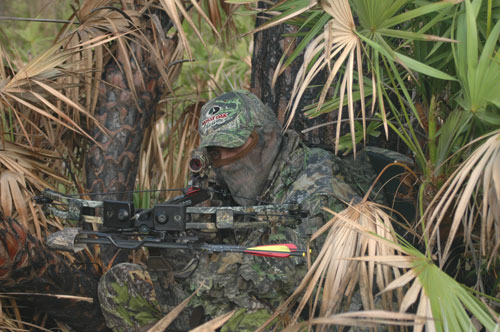
The same is true of crossbows. Within certain parameters you have plenty of options to choose from. Ultimately, however, you’ll want one that is designed specifically for hunting — and not all are. Some, like youth models, are meant for target and recreational shooting or small-game hunting. There’s even one ostensibly designed as a tactical assault bow. Even among those that could be considered hunting bows, not all are sufficient for big game. It’s not quite the same as the debate about which is the best deer caliber, but there are some distinct differences within and among crossbows.
Draw Weight
The principle specification that distinguishes a hunting bow is draw weight. Fortunately, most states have taken the guesswork out of determining what is sufficient by establishing a regulatory minimum. Those regulations vary considerably from state to state. However, the overall range runs from 75 to 125 pounds of draw weight. With little exception, any crossbow in that range should be adequate to kill a whitetail.
The next question is, are you willing to settle for adequate? Most of the better hunting bows are in the 150- to 175-pound range, with a few topping out over 200 pounds. In general, bigger is better, or in this case, faster. You want to be careful, though, because some states might have a maximum draw weight.
Why Faster Is Better
The most recent trend in archery equipment has been speed. Both crossbow and compound bow makers continually strive to push the speed envelope. That, of course, adds plenty of fodder for hunting camp (and chat room) debates. The knock on faster compounds is the inverse relationship between speed and accuracy. You can make vertical compounds faster by increasing the draw weight or the eccentricity of the wheels or by reducing the brace height, all of which make the bow more difficult to draw and/or hold, as well as amplify flaws in your shooting form. Ipso facto, accuracy is reduced.
You make crossbows faster somewhat similarly by increasing the draw weight or lengthening the powerstroke. However, because the limbs and string are mounted on a stock, the shooting platform is more stable. Form flaws (if there is such a thing with crossbows) are not exaggerated, so accuracy is not diminished. This is especially true if you’re shooting off any kind of rest, like a monopod or shooting rail, as many crossbow hunters do. Also, because you’ll be using some type of crank or pulley device to cock the bow well in advance, having to pull back the additional weight is not a factor.
Why all the fuss abo ut speed anyway? If you’re a bowhunter, you already understand. But if you’re a rifle hunter new to the bowhunting world, or a compound shooter who still believes crossbows offer a significant advantage, read on. In dry air at 68 degrees Fahrenheit, sound waves travel at 1,125 feet per second (fps). Even with the fastest-rated hunting crossbow, the sound of the arrow leaving the bow will get to the deer three times faster than the arrow itself. Granted, we’re talking fractions of a second, but that’s how quickly a deer can react to the sound of a bowstring. I have witnessed it, and there are videos that have documented deer reflexively ducking under an arrow. You try to counteract that with greater speed. Faster arrows also drop less, making precise range estimation a bit less critical than with slower arrows.
ut speed anyway? If you’re a bowhunter, you already understand. But if you’re a rifle hunter new to the bowhunting world, or a compound shooter who still believes crossbows offer a significant advantage, read on. In dry air at 68 degrees Fahrenheit, sound waves travel at 1,125 feet per second (fps). Even with the fastest-rated hunting crossbow, the sound of the arrow leaving the bow will get to the deer three times faster than the arrow itself. Granted, we’re talking fractions of a second, but that’s how quickly a deer can react to the sound of a bowstring. I have witnessed it, and there are videos that have documented deer reflexively ducking under an arrow. You try to counteract that with greater speed. Faster arrows also drop less, making precise range estimation a bit less critical than with slower arrows.
And by the way, because crossbows are inherently louder than compounds, noise suppression takes on added importance. A good hunting bow will have various types of noise- and vibration-dampening technology built into the limbs, stock, rail and various moving parts.
Size Matters
Width and weight are two other attributes of a good hunting bow. You’ve got to carry it to and from your stand and hold it up to shoot (unless you’re using a rest). That makes light weight an asset. With synthetic stocks and lightweight alloy risers and rails, most hunting crossbows weigh less than 10 pounds. You also want your bow to be maneuverable, especially when you’re still-hunting or sitting in a ground blind.
Other Factors
A couple more items are worth mentioning. While not mandatory, a camouflage finish is certainly worthy of strong consideration. Bowhunting is a close-range game. Your shooting distances are essentially the same as those of the vertical compound shooter, which calls for maximum concealment. At the very least, your bow should be dull-colored, with no shiny metal parts.
Another item is your sighting system. You can use a simple one-, two- or three-pin arrangement. However, optics are a much better choice. In fact, the vast majority of hunting crossbows now come with some type of optical sight system — usually either a zero-power three-dot sight or a 4X three-reticle scope. Which you choose is largely a matter of personal preference (and in a few cases, state law).






